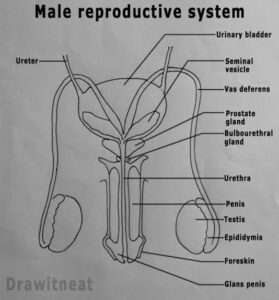
The male reproductive system comprises:
i. Primary sex organs (Gonads): Testes
ii. Accessory organs: Accessory ducts and glands
iii. External genitalia: Scrotum and Penis
i. Primary Sex Organs (Gonads): Testes
The testes are mesodermal, oval-shaped organs located outside the abdomen in the scrotum. They develop in the abdominal cavity during early fetal life, later descending into the scrotal sac through the inguinal canal. Suspended by the spermatic cord, they are about 4 to 5 cm long, 2 to 3 cm wide, and 3 cm thick. The outermost covering is the dense fibrous membrane called the tunica albuginea.
ii. Accessory Organs: Accessory Ducts and Accessory Glands
a. Accessory Ducts:
1. Rete Testis: Forms a network at the posterior surface, opening into vasa efferentia.
2. Vasa Efferentia: 12-20 fine tubules carrying sperm from the testis to the epididymis.
3. Epididymis: A long, coiled tube with upper, middle, and lower regions where sperm undergo maturation.
4. Vasa Deferens: Travels to the abdominal cavity, looping over the ureter, joining the seminal vesicle to form the ejaculatory duct.
5. Ejaculatory Ducts: Pass through the prostate gland, opening into the urethra.
6. Urethra: Common passage for urine and semen, extending through the penis, opening to the outside through the urethral meatus.
b. Accessory Glands:
1. Seminal Vesicles: Fibromuscular pouches behind the urinary bladder, secreting seminal fluid containing citric acid, fructose, fibrinogen, and prostaglandins.
2. Prostate Gland: Located under the urinary bladder, releasing a milky white, alkaline prostatic fluid into the urethra, forming about 30% of semen.
3. Cowper’s Glands: Pea-sized, lying on either side of the membranous urethra, secreting a viscous, alkaline, mucous-like fluid acting as a lubricant during copulation.
iii. External Genitalia: Scrotum and Penis
a. Penis:
The cylindrical and muscular male copulatory organ features three bundles of erectile tissue: a pair of corpora cavernosa and a median corpus spongiosum. The tip is called the glans penis, covered by the foreskin or prepuce.
b. Scrotum:
A loose pouch of pigmented skin behind the penis, divided into right and left scrotal sacs. The testes remain suspended by the spermatic cord, and the cremaster and dartos muscles help regulate testis temperature for spermatogenesis.
The failure of the testis to descend into the scrotum is called cryptorchidism, resulting in sterility.